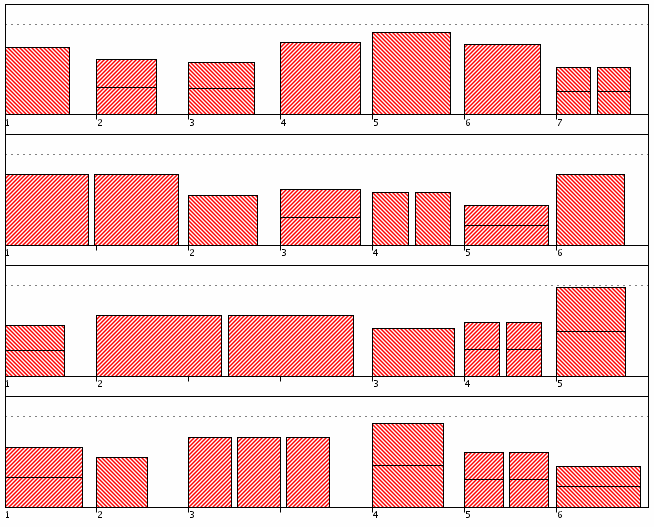Slotting cartons or pieces into a forward-pick area
This program slots cartons and/or pieces (eaches) in the forward-pick area. Examples of forward-pick areas that hold cartons and/or eaches include:
- Carton flow rack that is restocked from bulk storage.
- Static shelving that is backed up by secondary, overstock locations
- Bins
- Carousels
- A-frames
This program includes models of the geometry of all skus and all storage and so produces a detailed slotting plan, as shown below. This includes specifying carton orientation, number of lanes, and stack level for each sku. In addition, it can determine the best height of the shelf opening.

Run it from here!
Please read the license and disclaimers, then click to launch the latest version via Java Webstart:
Recent changes to the Java security model and to the Georgia Tech server may require that you to give explicit permission to run programs from the Georgia Tech site. Here is how to do that:
- On PCs this needs to be done only once: Open the Control Pane; on Macs, open System Preferences. Then, on either Mac or PC, select the Java Control Panel and click on the Security tab. and then on the button “Edit Site List”. Finally, add https://www.warehouse-science.com to the exception site list.
- In addition, if you use a Mac, you will have to do the following each time you use the program: Go to System Preferences and select Security. Change the setting “Allow apps downloaded from:” to “Anywhere”. (Be sure to change it back after running the program.)
These instructions work with all browsers except possibly Internet Explorer, so you will have to use an alternative such as Firefox, Chrome, or Safari. And should the program not start automatically, locate the jnlp file in your Downloads folder and open it with Java Webstart.
Also note that some company firewalls may still prevent Java Webstart programs from running, in which case see your system administrator.
You must return to this page and click on the button again each time you want to run the program. The first time you run it, Java Webstart downloads the program files to your machine. Thereafter, it will first download any available upgrades before starting the application. If there have been no upgrades, the application will start immediately.
Need Java?
This program is written in Java so it runs on any of Windows, Mac OS 10+, or Linux. If you do not already have Java installed, get the latest version of the Java Runtime Environment (JRE) here.
Distinctive features of the program
This program slots skus—but it also does much more, because it is based on an integrated model of labor (picking plus restocking) as well as the geometry of the skus and of the storage. More specifically, the program:
- Determines which skus should be stored in the forward-pick area, your most valuable warehouse real estate
- Allocates the optimal amount of space to each sku chosen for forward storage.
- Optimally configures your storage by choosing the right shelf heights
- Slots the product in the right orientation, stack height, etc., all while observing golden-zoning, product groupings, etc.
In other words, this program computes a fully actionable slotting plan, complete with pictures of what each slotted section of storage will look like. Furthermore, it accomplishes all this is a way that is provably optimal, to minimize your total labor costs—picking plus restocking.
Because it minimizes total labor hours, this program can be used to evaluate design alternatives. For example, you can compute exactly how much labor, based on the size and popularity of your skus, might be saved by adding 10 more bays of flow rack; or and so you can tell exactly what those 10 bays of flow rack are worth to you.
You can read details of the mathematical model on which this program is based in the book.
How to use the program
The steps of the program are numbered to make it easy to follow. You can try it yourself with this set of sample data.
To help you get prepare your data, you may find it helpful to use this MS Access database, which has the data fields already defined and which does some simple error-checking.
For more details, see the list of Frequently Asked Questions or walk through these illustrative slotting exercises.